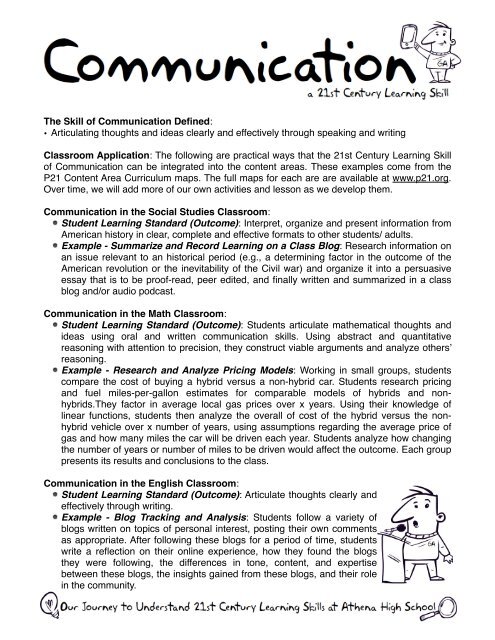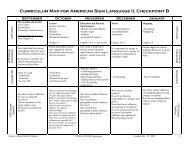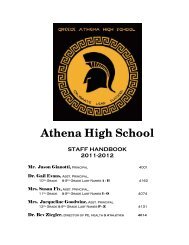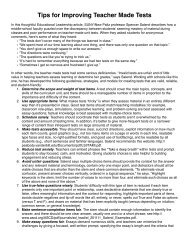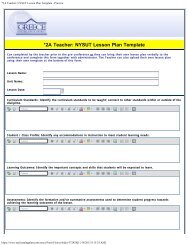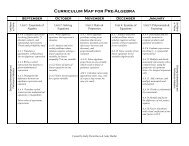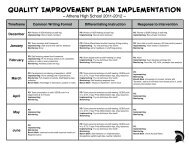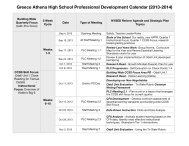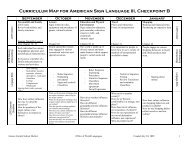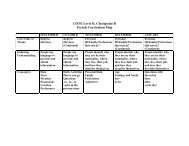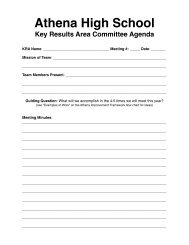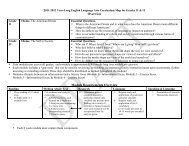21st CLS - Communication - Greece Athena Staff Blog
21st CLS - Communication - Greece Athena Staff Blog
21st CLS - Communication - Greece Athena Staff Blog
Create successful ePaper yourself
Turn your PDF publications into a flip-book with our unique Google optimized e-Paper software.
The Skill of <strong>Communication</strong> Defined:<br />
• Articulating thoughts and ideas clearly and effectively through speaking and writing<br />
<br />
Classroom Application: The following are practical ways that the <strong>21st</strong> Century Learning Skill<br />
of <strong>Communication</strong> can be integrated into the content areas. These examples come from the<br />
P21 Content Area Curriculum maps. The full maps for each are are available at www.p21.org.<br />
Over time, we will add more of our own activities and lesson as we develop them. <br />
<br />
<strong>Communication</strong> in the Social Studies Classroom:<br />
Student Learning Standard (Outcome): Interpret, organize and present information from<br />
American history in clear, complete and effective formats to other students/ adults.<br />
Example - Summarize and Record Learning on a Class <strong>Blog</strong>: Research information on<br />
an issue relevant to an historical period (e.g., a determining factor in the outcome of the<br />
American revolution or the inevitability of the Civil war) and organize it into a persuasive<br />
essay that is to be proof-read, peer edited, and finally written and summarized in a class<br />
blog and/or audio podcast.<br />
<br />
<strong>Communication</strong> in the Math Classroom:<br />
Student Learning Standard (Outcome): Students articulate mathematical thoughts and<br />
ideas using oral and written communication skills. Using abstract and quantitative<br />
reasoning with attention to precision, they construct viable arguments and analyze others’<br />
reasoning.<br />
Example - Research and Analyze Pricing Models: Working in small groups, students<br />
compare the cost of buying a hybrid versus a non-hybrid car. Students research pricing<br />
and fuel miles-per-gallon estimates for comparable models of hybrids and nonhybrids.They<br />
factor in average local gas prices over x years. Using their knowledge of<br />
linear functions, students then analyze the overall of cost of the hybrid versus the nonhybrid<br />
vehicle over x number of years, using assumptions regarding the average price of<br />
gas and how many miles the car will be driven each year. Students analyze how changing<br />
the number of years or number of miles to be driven would affect the outcome. Each group<br />
presents its results and conclusions to the class.<br />
<br />
<strong>Communication</strong> in the English Classroom:<br />
Student Learning Standard (Outcome): Articulate thoughts clearly and<br />
effectively through writing.<br />
Example - <strong>Blog</strong> Tracking and Analysis: Students follow a variety of<br />
blogs written on topics of personal interest, posting their own comments<br />
as appropriate. After following these blogs for a period of time, students<br />
write a reflection on their online experience, how they found the blogs<br />
they were following, the differences in tone, content, and expertise<br />
between these blogs, the insights gained from these blogs, and their role<br />
in the community.
<strong>Communication</strong> in the Science Classroom:<br />
Student Learning Standard (Outcome): Students model the practices of research<br />
science by informing others about their work, developing effective explanations,<br />
constructing and defending reasoned arguments, and responding appropriately to critical<br />
comments about their explanations.<br />
Example - Peer Critique of School or District Electronic Journaling: Students produce<br />
a school or district-wide electronic journal to communicate work they are doing in their<br />
science classes on a specific unit or topic. Students develop criteria for peer review and<br />
critique each other’s work, modeling the process for professional journals.<br />
<br />
<strong>Communication</strong> in the Musical Arts Classroom:<br />
Student Learning Standard (Outcome): Students will communicate in a variety of<br />
contexts through a variety of artistic media, including technologies, to convey their own<br />
ideas and to interpret the ideas of others<br />
Example - Multimedia Analysis of Composers Methodology: Students examine how<br />
composers, artists, choreographers, and playwrights use the arts to communicate<br />
particular ideas, themes, or concepts (such as relationships, overcoming obstacles,<br />
optimism vs. pessimism), and to evoke particular emotions or feelings (joy, sadness,<br />
tension, relaxation) in the listener or viewer.They analyze and compare these devices and<br />
develop multimedia presentations illustrating how such communication occurs through<br />
each of the arts disciplines.<br />
<br />
<strong>Communication</strong> in the World Languages Classroom:<br />
Student Learning Standard (Outcome): Students in the novice range (1-3 years<br />
experience) are able to comprehend and use short memorized phrases and sentences.<br />
Example - Restaurant Menu Analysis: Students read several authentic menus and<br />
identify which would be appropriate for different people based on likes/dislikes and special<br />
dietary needs.<br />
Student Learning Standard (Outcome): Students in the intermediate range (4-5 years<br />
experience) are able to express their own thoughts, provide descriptions, and<br />
communicate about familiar topics using sentences and<br />
strings of sentences.<br />
Example - Restaurant Reviews: Students work in groups to<br />
research local restaurants and produce restaurant reviews in<br />
the target language. They map the restaurants on internet<br />
maps and give directions to the restaurants in the language.<br />
<br />
Looking For More Examples Click here for links to all the P21<br />
curriculum maps for each content area. Each map has dozens of<br />
examples and tips to help us on this journey.


